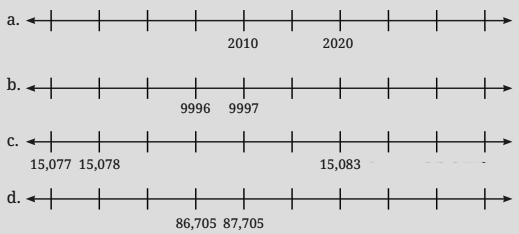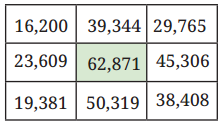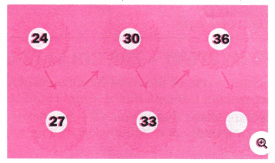Vedantu's Number Play Class 6 Solutions With Expert Guidance
FAQs on NCERT Solutions For Class 6 Maths Chapter 3 Number Play
1. How do you find the Highest Common Factor (HCF) of two or more numbers using the prime factorisation method as per the NCERT solutions for Class 6 Maths?
To find the HCF using the prime factorisation method, you should follow these steps as outlined in the NCERT solutions for the 2025-26 syllabus:
- Step 1: Find the prime factors of each given number separately.
- Step 2: Identify the prime factors that are common to all the numbers.
- Step 3: For each common prime factor, take the one with the lowest power.
- Step 4: The HCF is the product of these common prime factors with their lowest powers. For example, to find the HCF of 12 and 18, their prime factors are 12 = 2² x 3 and 18 = 2 x 3². The common factors are 2 and 3. The product of their lowest powers is 2¹ x 3¹ = 6.
2. What are the two primary methods to find the Least Common Multiple (LCM) of numbers in Class 6 Maths Chapter 3?
The NCERT solutions for Chapter 3, Number Play, explain two main methods for calculating the LCM:
- Prime Factorisation Method: First, find the prime factors of each number. Then, multiply the highest power of all the prime factors that appear in any of the numbers.
- Common Division Method: Arrange the numbers in a row and divide them by the smallest prime number that can divide at least one of them. Carry forward the numbers that are not divisible. Continue this process until the quotients are all 1. The LCM is the product of all the prime divisors used.
3. When solving word problems in Chapter 3, how do you decide whether to calculate the HCF or the LCM?
This is a common point of confusion. Here is a simple way to decide which method to use:
- Calculate the HCF (Highest Common Factor) when the problem asks for the greatest, maximum, or largest size/number for dividing different quantities into equal groups or rows. For example, finding the largest tape to measure two different lengths exactly.
- Calculate the LCM (Least Common Multiple) when the problem asks for the smallest, minimum, or least quantity/time when something will happen again simultaneously. For example, finding the time when two bells ringing at different intervals will ring together again.
4. How do you perform the divisibility test for 11 as explained in NCERT Chapter 3?
To check if a number is divisible by 11, you use the following step-by-step method:
- Step 1: Find the sum of the digits at the odd places (from the right).
- Step 2: Find the sum of the digits at the even places (from the right).
- Step 3: Calculate the difference between these two sums.
- Step 4: If the difference is either 0 or a multiple of 11 (like 11, 22, etc.), then the original number is divisible by 11.
5. Why is the number 1 considered neither a prime number nor a composite number?
The number 1 is unique because it doesn't fit the definition of either prime or composite numbers:
- A prime number has exactly two distinct factors: 1 and the number itself. For example, the factors of 7 are 1 and 7.
- A composite number has more than two factors. For example, the factors of 6 are 1, 2, 3, and 6.
The number 1 has only one factor, which is 1. Since it does not have exactly two factors or more than two factors, it is classified as neither prime nor composite.
6. What is the step-by-step process to check if two numbers are co-prime according to NCERT guidelines?
Two numbers are considered co-prime (or relatively prime) if they do not have any common factor other than 1. To check this, follow these steps:
- Step 1: Find the Highest Common Factor (HCF) of the two given numbers using either the prime factorisation or division method.
- Step 2: Check the value of the HCF.
- Step 3: If the HCF is 1, the numbers are co-prime. If the HCF is any number greater than 1, they are not co-prime. For instance, 8 and 15 are co-prime because their HCF is 1.
7. How do you solve problems like finding the smallest 3-digit number that is exactly divisible by 6, 8, and 12?
To solve this type of problem, which is common in NCERT exercises, you need to use the concept of LCM. Here are the steps:
- Step 1: First, find the LCM of the given divisors (6, 8, and 12). The LCM of 6, 8, and 12 is 24. This is the smallest number divisible by all three.
- Step 2: Now, find the multiples of the LCM (24) until you get the smallest one that is a 3-digit number.
- Step 3: The multiples of 24 are 24, 48, 72, 96, 120, 144, and so on.
- Step 4: The smallest 3-digit number in this list is 120, which is the required answer.
8. What is the relationship between the HCF and LCM of any two numbers, and how is it useful for solving problems?
There is a very important relationship between the HCF and LCM of any two numbers, 'a' and 'b'. The rule is:
Product of the two numbers = HCF of the numbers × LCM of the numbers
This formula (a × b = HCF(a,b) × LCM(a,b)) is extremely useful because if you know any three of these four values (the two numbers, their HCF, their LCM), you can easily calculate the fourth one. For example, if you know the HCF, LCM, and one of the numbers, you can find the other number.
9. What is Kaprekar's Constant for 4-digit numbers, and how do you reach it using the process described in the 'Number Play' chapter?
Kaprekar's Constant for 4-digit numbers is 6174. It's a special number reached through a fun process called Kaprekar's routine, which works for any 4-digit number that doesn't have all four digits identical. The steps are:
- Step 1: Take any 4-digit number (e.g., 3524).
- Step 2: Arrange its digits in descending order (5432) and ascending order (2345) to form two new numbers.
- Step 3: Subtract the smaller number from the larger one (5432 - 2345 = 3087).
- Step 4: Repeat the process with the result. No matter which number you start with, this process will eventually lead you to 6174.
10. If a number is divisible by 12, does it mean it must also be divisible by all the factors of 12, such as 2, 3, 4, and 6? Explain the rule.
Yes, absolutely. This is a fundamental property of divisibility explained in Chapter 3. The rule states: If a number is divisible by another number, it is also divisible by each of the factors of that number.
Since the factors of 12 are 1, 2, 3, 4, 6, and 12, any number that is divisible by 12 (like 36 or 60) will also be perfectly divisible by 2, 3, 4, and 6. This rule is very helpful for checking divisibility quickly without performing actual division.























































